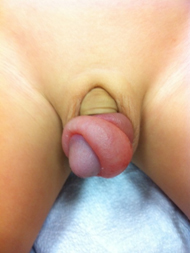Resumo
Definição
História e exame físico
Principais fatores diagnósticos
- presença de fatores de risco
- neonatos e bebês
- localização anormal da uretra
- prepúcio incompleto
- curvatura e/ou torção peniana
- exame ou procedimento genital recente
- história de pênis curto ou pequeno
- dor e edema peniano
- prepúcio aderente à glande
- aderências penianas e esmegma
- cicatriz peniana
- edema da glande
- coxim gorduroso pré-púbico proeminente
- presença de hérnia ou hidrocele
Outros fatores diagnósticos
- retração forçada do prepúcio
- dispareunia
- trauma peniano recente
- história de balanite ou balanopostite
- obstrução ou retenção urinária
- necrose da pele peniana
- descoloração da glande
- discrepância do comprimento peniano
- história de infecção do trato urinário
- história de cirurgia pélvica ou geniturinária
- disfunção erétil
Fatores de risco
- pênis não circuncidado (parafimose)
- sonda vesical de demora (parafimose)
- desconhecimento parental (fimose)
- balanite xerótica obliterante (fimose)
- trauma peniano (fimose)
- balanite e balanopostite recorrentes (fimose)
- baixo peso ao nascer (hipospádia)
- parto prematuro (hipospádia)
- diabetes gestacional, obesidade materna, hipertensão materna, idade materna avançada (hipospádia)
- história familiar (hipospádia, curvatura e/ou torção peniana congênita)
- obesidade (pênis embutido)
- circuncisão (pênis encarcerado)
- cicatrização peniana e na parte inferior do abdome (pênis embutido)
- hérnia ou hidrocele (pênis embutido)
- Polimorfismo V89L do gene SRD5A2 (hipospádia)
Investigações diagnósticas
Primeiras investigações a serem solicitadas
- diagnóstico clínico
Algoritmo de tratamento
fimose pré-puberal, congênita ou fisiológica
fimose pós-puberal
parafimose
hipospádia
curvatura e/ou torção peniana congênita
pênis oculto com <3 anos de idade (antes do treinamento esfincteriano)
pênis oculto com ≥3 anos de idade (após treinamento esfincteriano)
micropênis
Colaboradores
Autores
Kathleen Kieran, MD, MSc, MME
Director of Pediatric Urology Fellowship
Professor and Vice Chair for Equity, Diversity, and Inclusion
Department of Urology
University of Washington
Seattle
WA
Declarações
KK declares that she has no competing interests.
Agradecimentos
Dr Kathleen Kieran would like to gratefully acknowledge Dr Nicol Corbin Bush, Dr Nicholas Cost, Dr Linda Baker, and Dr Michael Holzer, previous contributors to this topic.
Declarações
NCB, NC, LB, and MH declare that they have no competing interests.
Revisores
David Bloom, MD
Chair
Department of Urology
The Jack Lapides Professor of Urology
University of Michigan Medical School
Ann Arbor
MI
Declarações
DB declares that he has no competing interests.
Vincent Gnanapragasam, MBBS, BMedSci, PhD, FRCSEng, FRCSEd(Urol)
Lecturer in Uro-oncology and Consultant Urological Surgeon
Department of Urology
Addenbrooke's Hospital
Cambridge
UK
Declarações
VG declares that he has no competing interests.
Laurence Baskin, MD
Chief
Pediatric Urology
and Professor
Urology and Pediatrics
UCSF Children's Hospital
San Francisco
CA
Declarações
LB declares that he has no competing interests.
Créditos aos pareceristas
Os tópicos do BMJ Best Practice são constantemente atualizados, seguindo os desenvolvimentos das evidências e das diretrizes. Os pareceristas aqui listados revisaram o conteúdo pelo menos uma vez durante a história do tópico.
Declarações
As afiliações e declarações dos pareceristas referem--se ao momento da revisão.
Referências
Principais artigos
European Association of Urology; European Society for Paediatric Urology. EAU guidelines on paediatric urology. Apr 2024 [internet publication].Texto completo
Dave S, Afshar K, Braga LH, et al. Canadian Urological Association guideline on the care of the normal foreskin and neonatal circumcision in Canadian infants (full version). Can Urol Assoc J. 2018 Feb;12(2):E76-99.Texto completo Resumo
British Association of Paediatric Surgeons. Management of foreskin conditions. Jun 2006 [internet publication].Texto completo
Artigos de referência
Uma lista completa das fontes referenciadas neste tópico está disponível para os usuários com acesso total ao BMJ Best Practice.

Diagnósticos diferenciais
- Balanopostite
- Corpo estranho circundante
- Pênis encarcerado
Mais Diagnósticos diferenciaisDiretrizes
- EAU guidelines on paediatric urology
- Penile circumcision
Mais DiretrizesConectar-se ou assinar para acessar todo o BMJ Best Practice
O uso deste conteúdo está sujeito ao nosso aviso legal